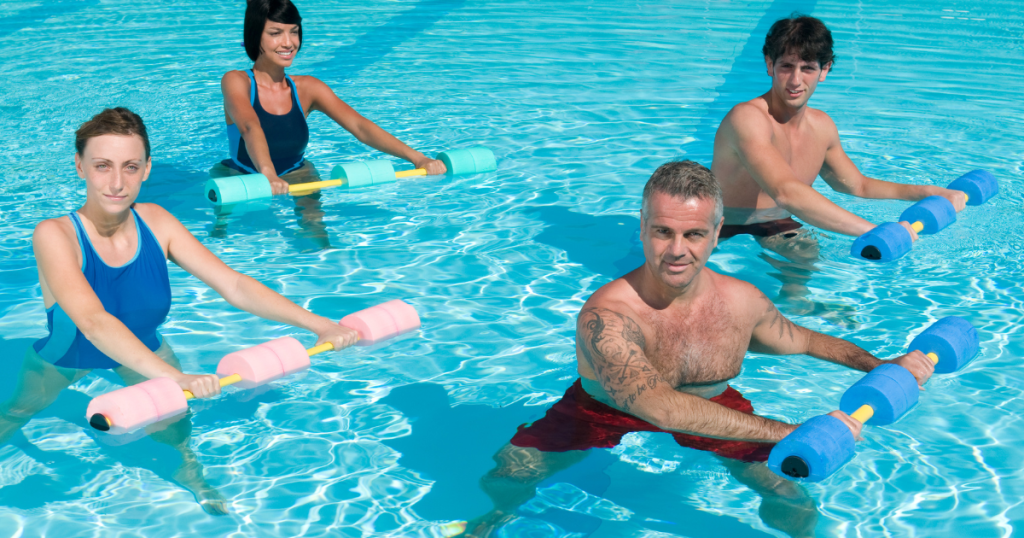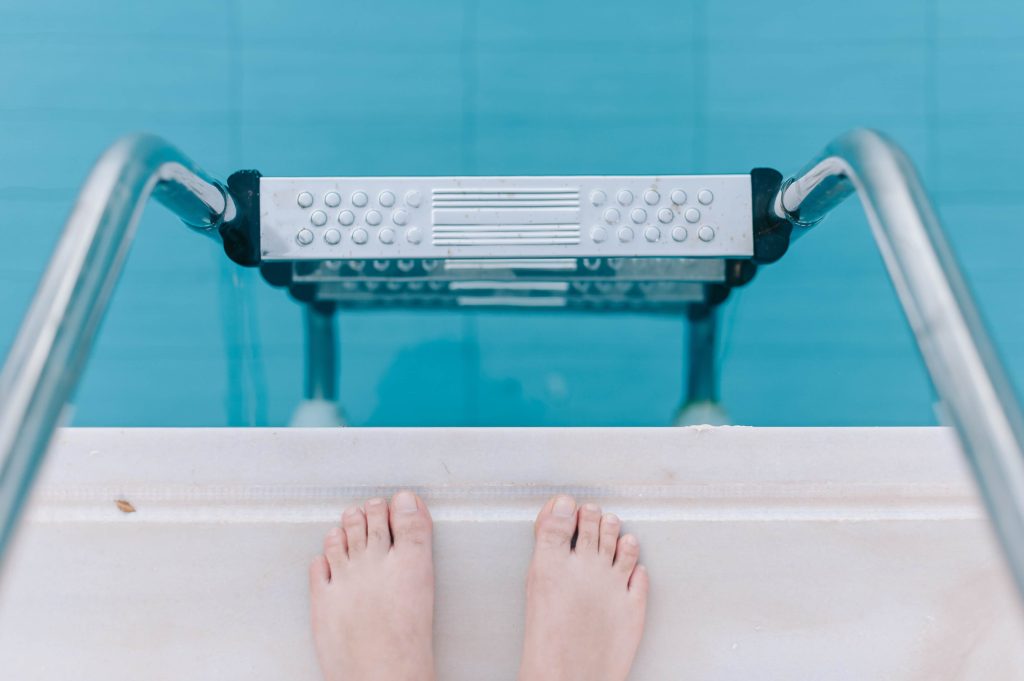Aquatic resistance training is a fun and effective way to build strength, improve endurance, and stay fit. The water’s natural resistance challenges your muscles while reducing stress on your joints.
This blog explores everything about aquatic resistance training, its benefits and how to get started. It also covers most commonly used equipment to start with equipment resistance training.
What is aquatic resistance training?
Aquatic resistance training is an exercise that uses water resistance to build strength and endurance. It can be performed in various ways, such as swimming with equipment, using water weights, or jogging in deep water.
What are the benefits of aquatic resistance training?
Aquatic resistance training has tremendous benefits for body and overall health. Here are the pros of engaging in water resistance training:
Reduced Stress
Participating in water exercises can help you reduce stress and anxiety. Exercising in water has a calm and soothing effect on your brain. This can result in better sleep after a tiring day.
Avoids Joint Strain
Working out on land is tough on weight-bearing joints especially for knees, hips, and ankles. If this type of pain sounds familiar to you, indulge in a water resistance training exercise. Training in warm water will allow you to strengthen your body and also relieve the usual pressure on those joints.
Cardiovascular Fitness
The inherent pressure of water on the body helps circulate blood more efficiently. It will also improve cardiovascular health. This means that your heart will work slightly harder and hence gaining strength with the time.
Reduces Chronic Pain
Water exercises are the best therapy for treating various chronic pains, especially the discomfort in the lower back. You can reduce body stiffness and soreness to a great extent by working against the water’s resistance. Water aerobics can even alleviate pain from chronic conditions like knee and hip osteoarthritis.
Aquatic aerobics are highly recommended for pregnant women suffering from lower back pain.
Enhanced Balance and Coordination
Exercising in water helps improve balance because the water supports your body, allowing you to move safely. The resistance of water forces your muscles to work harder to stay steady, improving coordination over time. This is especially useful for older adults or anyone recovering from injuries.
Reduces Blood Pressure
Water-based exercises help regulate blood pressure by improving circulation and reducing stress on the heart. The pressure of water naturally supports veins, helping blood flow more smoothly. This can lower the risk of heart disease and improve overall cardiovascular health.
Muscle Strengthening
Water resistance makes your muscles work harder than they would on land. Since water supports the body, you can strengthen muscles without putting too much stress on your joints.
Arthritis
Aquatic resistance training is gentle on the joints which make it ideal for people with arthritis. Water supports the body and reduces impact, helping to ease pain and stiffness. It also allows for a full range of motion, improving flexibility and mobility.
Become More Physically Fit
Working out in water helps improve overall fitness by combining strength training, cardio, and flexibility exercises. It engages multiple muscle groups while reducing strain on joints and bones.
Builds Endurance
Water provides constant resistance, requiring your muscles to work continuously as you move. This strengthens the heart and lungs which allows you to perform physical activities for longer periods.
Helps Burn Calories
Aquatic resistance training burns calories because your body works against water resistance with every movement. The harder you move, the more energy you use. Because of multiple body muscles that are engaging in the workout, you will burn as many calories as some land-based exercises.
Builds Endurance
Exercising in water helps build endurance by working muscles for longer periods without excessive fatigue. The resistance forces muscles to keep working and hence improves their ability to perform repeated movements. This enhances stamina and energy levels.
Tones Muscles
Water exercises help tone muscles by constantly engaging them against resistance. Unlike weights, water provides resistance from all directions. This helps shape and define muscles without straining the body.
Improves Body Composition
Regular aquatic training can improve body composition by reducing fat and increasing lean muscle mass. The resistance of water helps burn calories while strengthening muscles at the same time. Over time, this leads to a healthier and more toned physique.
Improves Blood Circulation
Water workouts improve blood circulation by promoting better blood flow throughout the body. The natural pressure of water helps reduce swelling and improve oxygen delivery to muscles. This can benefit people with circulation issues or those recovering from injuries.
Classic Water Aerobics
Traditional water aerobics combines cardio, strength training, and flexibility exercises in a low-impact setting. It includes movements like jumping jacks, leg lifts, and arm exercises, all performed in water. This helps improve heart health, muscle strength, and overall endurance.
Prevents Overheating
Water keeps your body cool while you exercise. This makes aquatic training ideal for hot weather or intense workouts. You can exercise longer without feeling exhausted or dehydrated.
Encourages Exercise
Water workouts are fun and refreshing and make it easier to stay active. Because aquatic training is low-impact, people of all fitness levels can participate. This encourages consistent exercise which leads to long-term health benefits.
Less Injury Concern
Since water supports the body, there is a lower risk of injury compared to land-based exercises. The buoyancy of water reduces strain on joints, muscles, and bones. This makes it a safer workout option for people recovering from injuries or with mobility issues.
Treats Sport Injuries
Aquatic resistance training helps athletes recover from sports injuries by providing a low-impact workout. It allows injured muscles and joints to move without added stress. Many athletes use water therapy to regain strength and flexibility safely.
Water Has Built-in Resistance
Unlike air, water provides natural resistance in every direction, making movements more challenging. This helps strengthen muscles without needing extra equipment like weights. The constant resistance also improves endurance and muscle tone over time.
Water Resistance Training: How to Get Started in Australia?
Water resistance training is a low-impact, full-body workout that uses the natural resistance of water to build strength and endurance. It is great for people recovering from injuries or those wanting to improve their fitness levels. Here is how you can get started!
1. Find the Right Pool
Look for a swimming pool with a shallow area where you can stand comfortably. A heated pool is best for muscle relaxation, especially for beginners.
2. Wear Proper Gear
A well-fitting swimsuit allows easy movement, and water shoes provide grip and stability. Optional gear like water dumbbells or resistance gloves can add intensity later.
3. Start with a Warm-Up
Before diving into exercises, do gentle water walking, arm circles, and light kicking to loosen up muscles and get used to water resistance.
4. Begin with Water Resistance Exercises
Now, it’s time to start with exercises including:
- Water Walking: This simple exercise involves walking in waist-high water. Engage your core and maintain an upright posture.
- Leg Lifts: Hold onto the pool’s edge and lift each leg as high as possible, working your hip flexors and lower abdomen.
- Arm Circles: Standing in waist-deep water, extend your arms and make circular motions to engage the shoulder muscles.
- Water Jogging: An intense version of water walking, water jogging engages more muscles and improves cardiovascular fitness.
- Flutter Kicks: Hold onto the pool’s edge, perform continuous kicks, and maintain straight legs and pointed toes to strengthen your core and legs.
- Pool Noodle Press: Using a pool noodle, press it down into the water, working your shoulders and upper body.
- Aqua Zumba: A dynamic, full-body workout that combines dance with aerobic moves in a choreographed water exercise.
5. Gradually Increase Difficulty
Once comfortable, add more resistance by moving faster, using water weights, or performing deeper movements. Try incorporating jumping, twisting, or using a kickboard for more intensity.
6. Cool Down and Stretch
Finish with slow movements like floating or stretching to relax muscles and improve flexibility. This prevents soreness and helps with recovery.
Water resistance training is safe, effective, and fun. Start with simple movements and gradually challenge yourself. Stay consistent, and you will see improvements in strength, balance, and overall fitness.
Common Equipment Used for Aquatic Resistance Training in Australia
Following are some of the most popular aquatic resistance training equipment used in Australia:
Water Dumbbells
Lightweight on land but provides resistance in water. Water dumbbells help to strengthen arms, shoulders, and upper body.
Resistance Gloves
Webbed gloves that increase resistance during arm movements. They are best for improving muscle tone and endurance.
Kickboards
Flat, buoyant boards that help with lower-body workouts by adding resistance to kicking exercises.
Aqua Resistance Bands
Stretchable bands designed for underwater use. Target different muscle groups with controlled resistance.
Water Ankle or Wrist Weights
Straps filled with water-friendly material that add extra resistance for strengthening legs and arms.
Buoyancy Belts
Help with floating while allowing free movement for core and leg workouts in deep water.
Pool Noodles
Versatile foam tubes used for support, resistance exercises, and core training.
Aqua Treadmills
Underwater treadmills designed for low-impact walking or running. They also improve endurance and cardiovascular health.
Hydro Discs or Paddles
Handheld discs or paddles that increase resistance for upper-body and arm exercises.
Water Trampolines
Aquatic trampolines provide a fun, low-impact way to improve balance, coordination, and leg strength.
Frequently Asked Questions
How does water resistance training work?
Water naturally provides resistance in all directions, making your muscles work harder with every movement. This helps build strength, improve endurance, and tone muscles without putting stress on joints. The resistance also slows movements, reducing the risk of injury.
Where can you perform water resistance training?
You can do water resistance training in a swimming pool, aquatic therapy center, or even a natural body of water like a lake. A pool with shallow and deep areas is best, allowing for different exercises and intensity levels. Some gyms and rehab centers also offer specialized water workout facilities.
How do you perform aquatic resistance training?
Start with basic exercises like water walking, leg lifts, and arm pushes to get used to water resistance. You can use equipment like water dumbbells, resistance gloves, or kickboards to increase intensity. Gradually add more complex moves, such as squats, lunges, or jogging in water, to challenge different muscle groups.
Is water resistance training suitable for individuals with arthritis?
Yes, it is one of the best forms of exercise for people with arthritis. Water supports the body, reducing pressure on joints while allowing gentle movement. This helps improve flexibility, reduce stiffness, and ease pain without causing strain.
What is the ideal duration and frequency for water resistance training sessions?
For beginners, 30 to 45 minutes per session, two to three times a week, is a good starting point. As you build endurance, you can increase to four or five sessions per week.
Conclusion
Water resistance training is a simple yet powerful workout that suits all fitness levels. It strengthens muscles, improves balance, and enhances overall health while being gentle on the joints.
Whether you’re recovering from an injury or looking for a new way to stay fit, water workouts can help. Start small, stay consistent, and enjoy the benefits of exercising in water!


